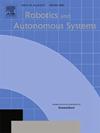Position-based acoustic visual servo control for docking of autonomous underwater vehicle using deep reinforcement learning
IF 4.3
2区 计算机科学
Q1 AUTOMATION & CONTROL SYSTEMS
引用次数: 0
Abstract
In this paper, a position-based acoustic visual servo control scheme is proposed to achieve efficient docking for underactuated autonomous underwater vehicle (AUV). To address the issue that docking station can hardly be kept in the limited field of onboard imaging sonar using conventional controllers, deep reinforcement learning (DRL) is proposed to learn an optimal control strategy to achieve both field control and precise docking. First, a visualized underwater docking environment is developed based on robotic operation system (ROS) and Gazebo platform, and imaging sonar is modeled to simulate acoustic image. Subsequently, a deep neural network-inspired detector and a state-of-the-art feature tracker are combined as the perceptual header of docking controller which transforms the output of imaging sonar to the input of control agent rapidly and precisely. Furthermore, cost terms of DRL-based control agents are further designed by incorporating two nonlinear functions with different gradients, yet the change rates of received rewards from the state observation are not same in different situations. In this case, the control agents are enabled to learn the strategy to eliminate offset and keep depth of AUV. Moreover, feature of docking station will also be well kept in acoustic image due to the rapid increasing punishment of great bearing angle when AUV is in high maneuvering. Furthermore, evaluation results and comparative experiments are presented to verify feasibility and efficiency of the proposed servo control scheme using deep reinforcement learning.
求助全文
约1分钟内获得全文
求助全文
来源期刊

Robotics and Autonomous Systems
工程技术-机器人学
CiteScore
9.00
自引率
7.00%
发文量
164
审稿时长
4.5 months
期刊介绍:
Robotics and Autonomous Systems will carry articles describing fundamental developments in the field of robotics, with special emphasis on autonomous systems. An important goal of this journal is to extend the state of the art in both symbolic and sensory based robot control and learning in the context of autonomous systems.
Robotics and Autonomous Systems will carry articles on the theoretical, computational and experimental aspects of autonomous systems, or modules of such systems.
 求助内容:
求助内容: 应助结果提醒方式:
应助结果提醒方式:


